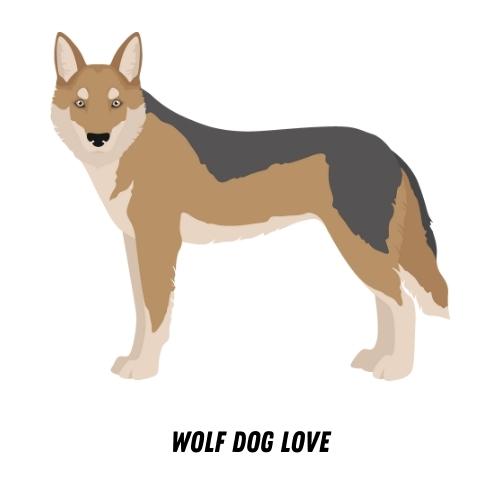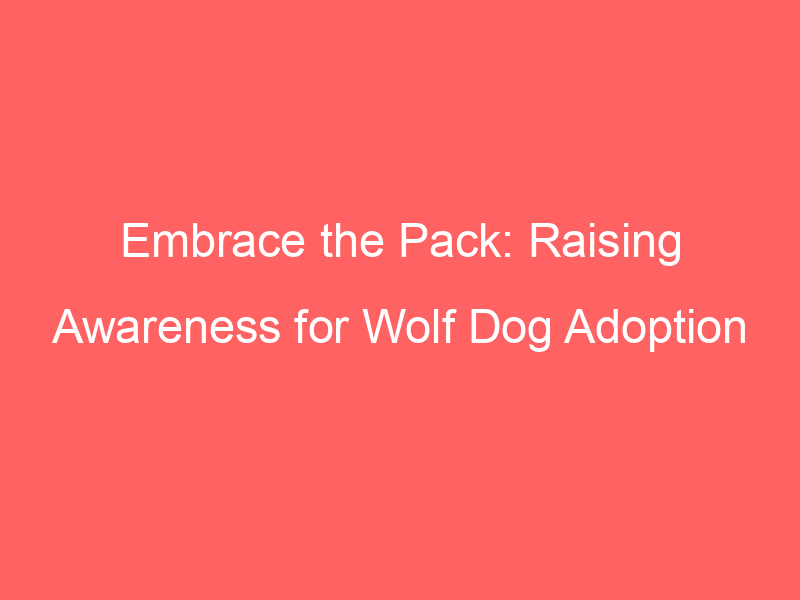Introduction to Wolf Dog Breeds
Wolf Dog breeds are a fascinating mix of wild and domesticated animals. They are the result of a wolf and a domestic dog’s cross-breeding. These breeds are unique, and they carry the traits of both their parents. This article will provide an overview of Wolf Dog breeds and debunk some common misconceptions about them.
-
Overview of Wolf Dog Breeds
Wolf Dogs are not a single breed, but rather a category that includes any breed resulting from the mating of a wolf with a domestic dog. These breeds are known for their intelligence, strength, and agility. They are often larger than most domestic dogs, with a strong build and a coat that resembles that of a wolf.
Some of the most popular Wolf Dog breeds include the Czechoslovakian Wolfdog, Saarloos Wolfdog, and the Lupo Italiano. These breeds are known for their loyalty, intelligence, and high energy levels. However, owning a Wolf Dog breed requires a lot of time, patience, and understanding of their unique needs and behaviors.
-
Common Misconceptions about Wolf Dog Breeds
There are many misconceptions about Wolf Dog breeds. One common myth is that they are dangerous and aggressive. While Wolf Dogs are indeed powerful and can be protective, they are not inherently aggressive. Like any other dog, their behavior largely depends on their upbringing and training.
Another misconception is that Wolf Dogs are suitable pets for everyone. The truth is, these breeds require a lot of care, socialization, and training. They are not recommended for first-time dog owners. They do best in homes with experienced owners who understand their unique needs and can provide them with the care they require.
Understanding Wolf Dog Breeds
Wolf dogs are fascinating creatures that combine the traits of wild wolves and domestic dogs. To truly appreciate these unique animals, it’s important to understand their history and the different types of wolf dog breeds.
Wolf Dog Breed Information
Wolf dogs are not a single breed, but rather a category of dogs that have wolf ancestry. They come in a variety of shapes and sizes, each with their unique characteristics. Let’s delve into the history of wolf dog breeds and explore the different types of wolf dog breeds that exist today.
- History of Wolf Dog Breeds
- Types of Wolf Dog Breeds
The history of wolf dogs dates back thousands of years when humans first started to domesticate wolves. Over time, these domesticated wolves evolved into different breeds of dogs. However, some breeds retained more of their wolf-like characteristics than others, leading to the creation of wolf dog breeds. These breeds were often used for hunting and guarding due to their strength, intelligence, and keen senses.
There are several types of wolf dog breeds, each with its unique traits. Some of the most popular wolf dog breeds include the Saarloos Wolfdog, Czechoslovakian Wolfdog, and the American Alsatian. These breeds vary in size, temperament, and the amount of wolf DNA they possess. For instance, the Saarloos Wolfdog has a high percentage of wolf DNA and closely resembles a wolf in appearance and behavior. On the other hand, the American Alsatian is a large breed that looks like a wolf but has a more dog-like temperament.
Understanding wolf dog breeds is key to appreciating these remarkable animals. Whether you’re considering adopting a wolf dog or simply fascinated by them, gaining knowledge about their history and the different types of wolf dog breeds can enhance your appreciation for these unique creatures.
Wolf Dog Characteristics
Wolf dogs are fascinating creatures, a unique blend of domestic dog and wild wolf. They have distinctive characteristics that set them apart from other breeds. Let’s explore these characteristics in detail.
- Physical traits of Wolf Dogs
- Behavioral traits of Wolf Dogs
Wolf dogs are generally larger than most domestic dogs. They have a robust build, with males standing up to 33 inches tall at the shoulder and females slightly smaller. Their weight can range from 70 to 120 pounds. They have a thick double coat that comes in a variety of colors including white, black, gray, brown, and combinations of these.
Their eyes are usually almond-shaped and can be brown, blue, or a combination of both. They have large ears that stand erect and a long, bushy tail. Their teeth are strong and sharp, designed for tearing and chewing meat. Their paws are large and webbed, which helps them move easily in snow.
Wolf dogs are known for their intelligence and independence. They are often described as having a dual personality – the loyalty and affection of a dog, combined with the independence and instinctual behavior of a wolf. They are highly energetic and require a lot of physical and mental stimulation.
They are pack animals and form strong bonds with their human family, but they can be wary of strangers. They are also known to be territorial and may not get along well with other pets. They have a strong prey drive and may chase smaller animals. Training and socialization from a young age are crucial to manage these behaviors.
In conclusion, wolf dogs are unique and captivating creatures. Their physical and behavioral traits reflect their dual heritage. Owning a wolf dog can be a rewarding experience, but it also comes with challenges. It’s essential to understand these characteristics to provide the best care for these remarkable animals.
Versatility of Wolf Dogs
Wolf Dogs are a fascinating breed, known for their versatility. They possess traits that make them adaptable to various environments and roles.
Wolf Dog Breed Traits
Wolf Dogs possess unique breed traits that contribute to their versatility. Let’s explore some of these traits in detail.
- Adaptability of Wolf Dogs
- Wolf Dogs in various roles
Wolf Dogs are highly adaptable creatures. They can thrive in different environments, from cold, snowy regions to warm, sunny areas. This adaptability is a result of their genetic makeup, which combines the hardiness of wolves and the versatility of dogs. Their ability to adapt to different climates and environments makes them suitable for various roles, from being a family pet to a working dog.
Wolf Dogs can play various roles due to their intelligence and adaptability. They can be trained as service dogs, therapy dogs, or even as actors in movies and TV shows. Their keen senses and alertness also make them excellent search and rescue dogs. Moreover, their protective nature and loyalty make them great family pets and guard dogs. However, it’s important to note that their suitability for these roles depends on their individual temperament, training, and socialization.
In conclusion, the versatility of Wolf Dogs is a testament to their unique breed traits. Their adaptability and ability to fit into various roles make them a truly remarkable breed.
Wolf Dog Behavior
Wolf dogs are unique creatures with behaviors that can be fascinating to understand. Let’s delve into the world of wolf dog behavior and explore the factors that influence it.
- Understanding Wolf Dog Behavior
- Factors influencing Wolf Dog Behavior
Wolf dogs are a blend of domestic dog and wild wolf traits, which makes their behavior quite unique. They are known for their intelligence, independence, and strong pack mentality. These animals are often more curious, active, and explorative than regular dogs. They also tend to be more reserved and cautious around strangers.
Wolf dogs communicate in a variety of ways. They use body language, vocalizations, and even scent marking to express themselves. For instance, a wagging tail can indicate happiness, while a lowered tail might mean the wolf dog is feeling submissive or scared.
It’s important to remember that every wolf dog is an individual. Their behavior can vary widely depending on their specific genetic makeup, upbringing, and environment.
Several factors can influence the behavior of a wolf dog. These include their genetics, environment, and training.
| Factor | Explanation |
|---|---|
| Genetics | Wolf dogs inherit traits from both their wolf and dog ancestors. This can influence their behavior in various ways. For example, they might have a strong prey drive from their wolf heritage, or a desire to please their human family from their dog side. |
| Environment | The environment in which a wolf dog is raised can greatly impact their behavior. Wolf dogs need plenty of space to roam and explore. They also need mental stimulation to keep them happy and healthy. A lack of these can lead to behavioral problems. |
| Training | Training plays a crucial role in shaping a wolf dog’s behavior. These animals are intelligent and can learn quickly, but they also require consistent, positive reinforcement training methods. Harsh or punitive training can lead to fear and aggression. |
Understanding and respecting the unique behavior of wolf dogs can lead to a rewarding and fulfilling relationship with these remarkable animals.
Training Wolf Dog Breeds
Wolf dogs are unique breeds that require specialized training methods. These breeds are intelligent, energetic, and require a lot of mental and physical stimulation. Training a wolf dog is not a task to be taken lightly, but with the right techniques and early socialization, it can be a rewarding experience.
- Training techniques for Wolf Dogs
- Positive Reinforcement: This involves rewarding your wolf dog for good behavior. Rewards can be treats, toys, or praise. This encourages them to repeat the behavior.
- Clicker Training: This is a method where a clicker is used to mark the exact moment the dog performs the desired behavior. The click is followed by a reward, helping the dog understand what it did right.
- Consistency: Consistency is key in training any dog breed. Ensure all family members use the same commands and reward system to avoid confusing your wolf dog.
- Importance of early socialization
- Exposure: Gradually expose your wolf dog to different environments, people, and animals. This helps them become comfortable in various situations.
- Puppy Classes: Puppy classes are a great way for your wolf dog to interact with other dogs and people. It also helps them learn basic obedience commands.
- Patience: Remember, socialization is a process. It takes time and patience. Don’t rush your wolf dog; let them take their time to get comfortable in new situations.
Training a wolf dog requires patience, consistency, and understanding. Here are some techniques that can be useful:
Socialization is a crucial part of a wolf dog’s training. It helps them get used to different environments, people, and other animals. It’s best to start socialization early when they are puppies.
In conclusion, training a wolf dog requires a lot of patience, consistency, and early socialization. But with the right techniques, you can train your wolf dog to be a well-behaved and happy member of your family.
Wolf Dog Breed Care
When it comes to the care of Wolf Dog breeds, there are two main areas to focus on: nutrition and health. These two factors play a significant role in the overall well-being and longevity of these unique dogs.
Nutrition and Health
Like any other breed, Wolf Dogs have specific dietary and health needs. Let’s delve into these areas to ensure your Wolf Dog stays healthy and happy.
- Dietary needs of Wolf Dogs
- Common health issues in Wolf Dogs
Wolf Dogs are known for their high energy levels, which means they require a diet rich in protein. A balanced diet for a Wolf Dog should include high-quality dog food, preferably one that is grain-free and includes a good source of animal protein like chicken, beef, or fish. It’s also important to include fruits and vegetables for vitamins and minerals. Remember, every dog is unique, so it’s best to consult with a vet to determine the most suitable diet for your Wolf Dog.
Wolf Dogs are generally healthy, but they can be prone to certain health issues. Some common health problems include hip and elbow dysplasia, eye conditions, and heart disease. Regular check-ups with a vet can help detect these issues early. It’s also crucial to keep your Wolf Dog’s vaccinations and parasite treatments up to date to prevent common canine diseases.
In conclusion, taking care of a Wolf Dog’s nutrition and health is not too different from caring for any other breed. It requires a balanced diet, regular vet check-ups, and preventative treatments. With the right care, your Wolf Dog can lead a healthy and fulfilling life.
Grooming and Exercise
-
Grooming needs of Wolf Dogs
Wolf Dogs are known for their thick and luscious coats. These coats are not just for show, they serve a functional purpose, protecting the dogs from harsh weather conditions. However, this also means that Wolf Dogs require regular grooming to keep their coats healthy and shiny.
Wolf Dogs shed heavily, especially during the change of seasons. It’s recommended to brush their coats at least once a week to remove loose hair and prevent matting. This will also help distribute natural oils, promoting a shiny and healthy coat.
Bathing should be done sparingly, only when the dog is particularly dirty or has a bad odor. Over-bathing can strip the coat of its natural oils. Use a dog-specific shampoo that is gentle on the skin.
Regular grooming is not just about maintaining the coat. It also includes checking the dog’s ears for any signs of infection, trimming the nails, and brushing the teeth. This helps ensure overall health and well-being of your Wolf Dog.
-
Exercise requirements for Wolf Dogs
Wolf Dogs are highly active and energetic animals. They require a substantial amount of exercise to keep them physically and mentally stimulated. Lack of exercise can lead to behavioral problems such as excessive barking, chewing, and digging.
It’s recommended that Wolf Dogs get at least one to two hours of exercise each day. This can include walks, runs, playtime in the yard, or training sessions. They also enjoy activities that stimulate their minds, such as puzzle toys or agility training.
Remember, a tired Wolf Dog is a happy Wolf Dog. Regular exercise not only keeps your dog healthy, but also helps to build a strong bond between you and your furry friend.
Conclusion: The Amazing World of Wolf Dog Breeds
As we reach the end of our journey through the fascinating world of wolf dog breeds, it’s time to recap and reflect on what we’ve learned. These unique and versatile creatures are a testament to the beauty of nature and the power of selective breeding.
- Recap of Wolf Dog Breed Traits
- Final thoughts on the Versatility of Wolf Dogs
Wolf dog breeds are a blend of domestic dog and wild wolf, resulting in a creature that is both familiar and exotic. They possess a striking appearance, often inheriting the piercing eyes and muscular build of their wolf ancestors. Their traits can vary, but generally, they are intelligent, loyal, and energetic animals.
Wolf dogs are known for their high energy levels and need for mental and physical stimulation. They are not suitable for every household, but for the right owner, they can make a rewarding and loyal companion. They require a lot of space to roam and a dedicated owner who can meet their unique needs.
The versatility of wolf dogs is truly remarkable. They can adapt to a variety of environments and tasks, from search and rescue work to acting roles in film and television. Their intelligence and trainability make them suitable for a variety of roles, but they also require a lot of care and attention to ensure they are happy and healthy.
Wolf dogs are not for everyone, but those who choose to welcome these unique creatures into their lives often find it a rewarding and enriching experience. They are a testament to the beauty and diversity of the canine world, and their unique traits and abilities make them a fascinating subject of study.
In conclusion, the world of wolf dog breeds is as diverse and complex as the creatures themselves. They are a testament to the power of genetics and the beauty of nature, and they continue to captivate us with their unique blend of wild and domestic traits. Whether you’re a potential owner or simply an admirer, there’s no denying the allure of these magnificent creatures.







